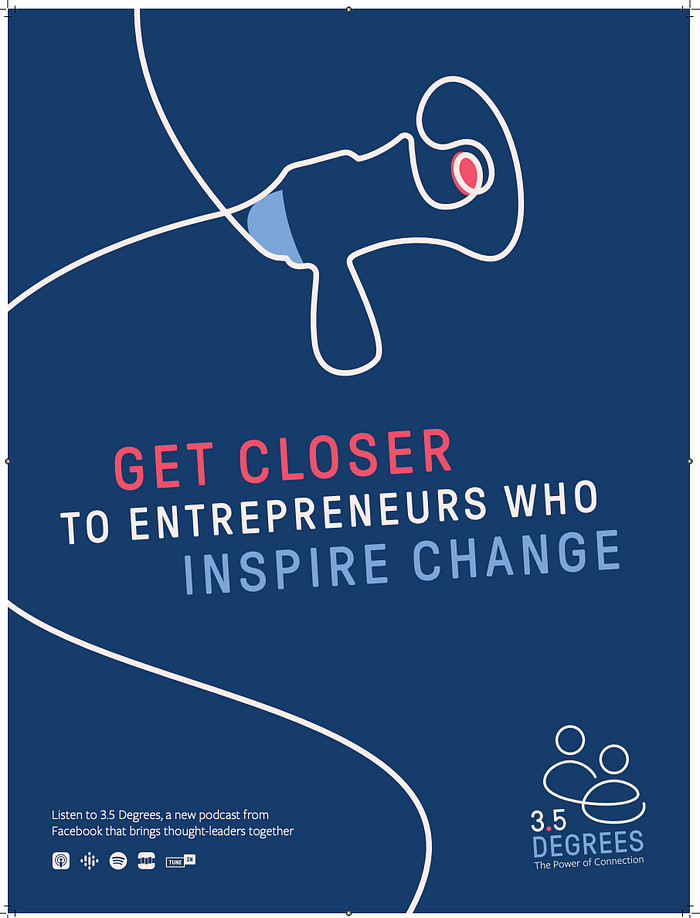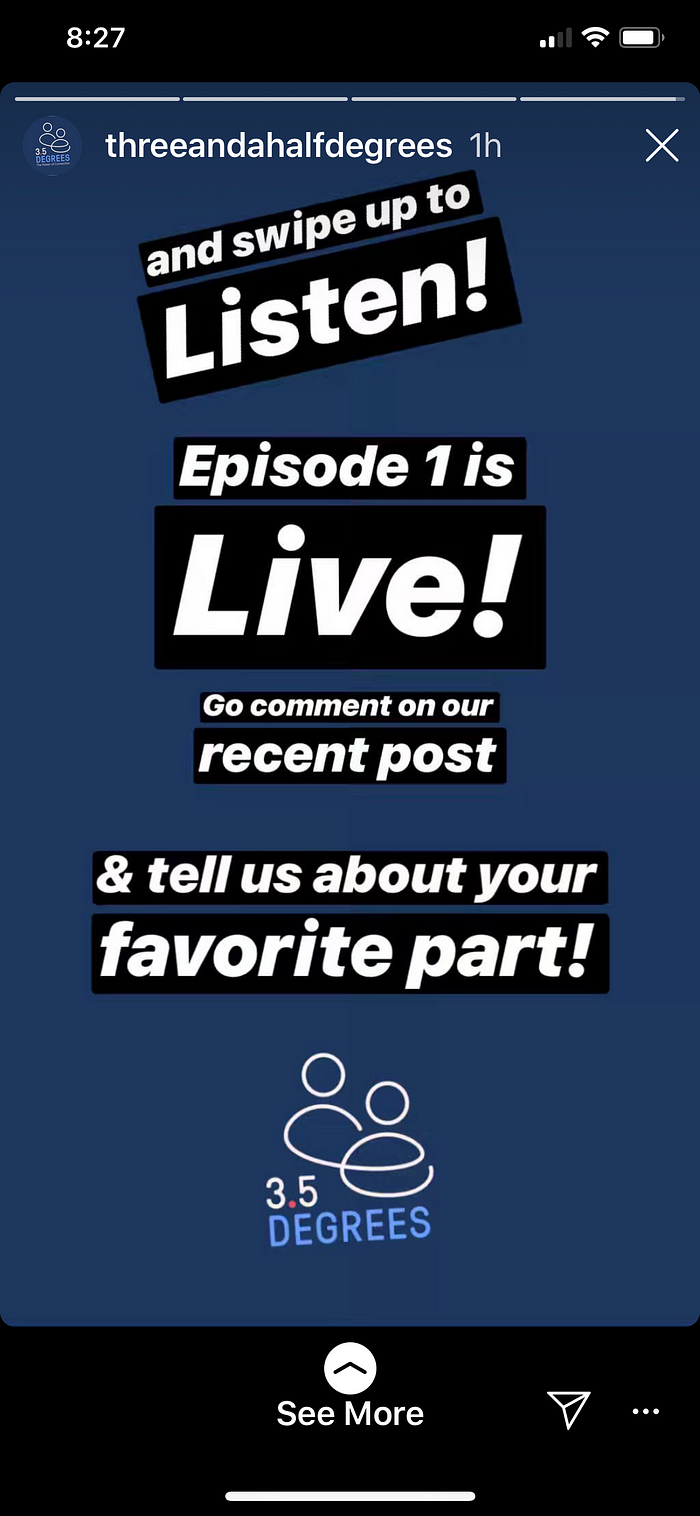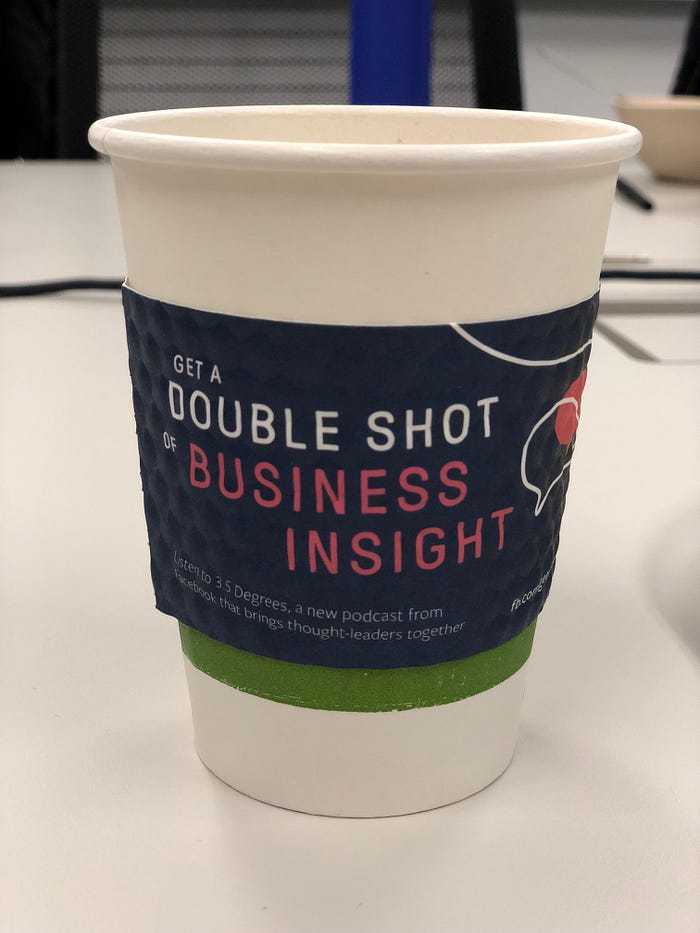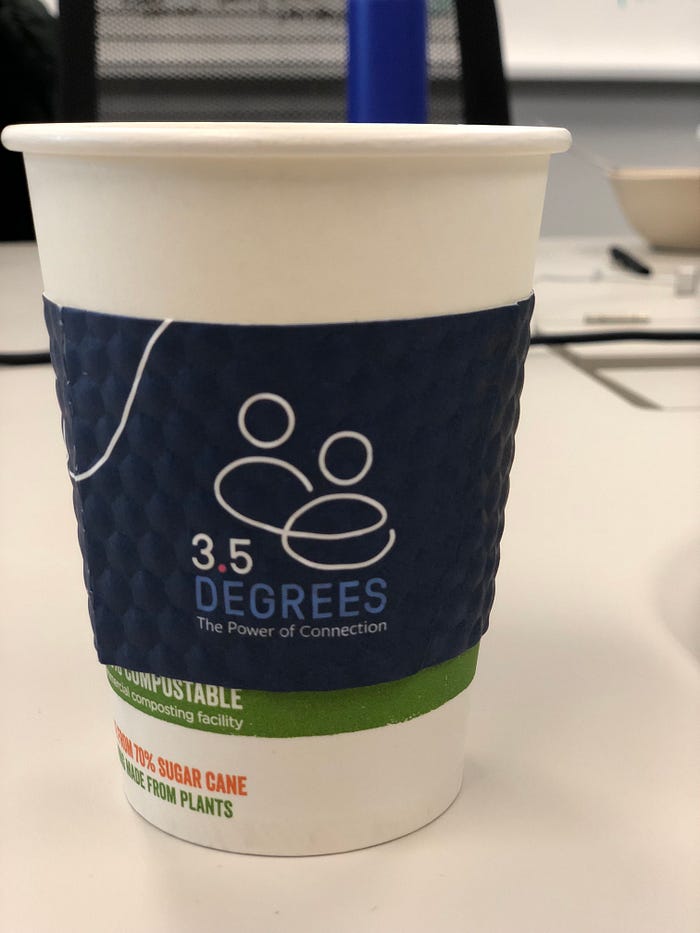9 Marketing Lessons for Podcasters: Inside the Strategy of Facebook’s New Podcast
Facebook just launched a new original podcast, Three and a Half Degrees. The show was conceived over a year ago with the goal of fulfilling Facebook’s mission of bringing the world closer together. The show itself is only half the story, though. The marketing plan for the series is the most comprehensive, creative, and committed of anyone we have worked with to date. One very prominent industry leader called it “the best podcast marketing plan I’ve seen.”
Throughout the production of the show, we’ve worked very closely with Matt Sutton, Global Brand Marketing Manager at Facebook. He’s led the marketing efforts for Three and a Half Degrees and very kindly agreed to share his strategy and tactics. There are a LOT of really creative and smart strategies in here.
Lesson 1: The Show Shouldn’t Be Explicit Marketing For Your Products or Services

When we talk with clients about how to decide what their podcast will be about, we often discuss Creative Bravery and the need for a light brand touch. Why? No listener wants to download an informercial. Matt and the team at Facebook intuitively understood this from day one:
“A small team of us proposed this idea of this podcast a little over a year ago. It was just a pure proposal to build something that would give back to the business and marketing community. Something that was by Facebook, but explicitly not about Facebook.”
The show concept evolved out of research that puts Kevin Bacon to shame. “It grew into this idea of the Three and a Half Degrees podcast, which is based on the study that we’re now connected by three and a half degrees instead of six. The concept is that the podcast will reduce those degrees of connection down to one for a pair of guests in each episode.
“We saw this as an opportunity to not talk about us. We thought that if we’re going to try and enter the space and do a compelling show for the industry, we wanted to do something that people would actually want to tune into, and we have these wonderful people who have stories that need to be told to the world.”
To sum up — a great podcast from a brand is not a podcast about the brand. It’s about what a brand is passionate about, what stories it can uniquely tell, and what distinct point of view it can bring to a show.
Owned Channels and Super Powers
We have talked a lot about the secret strengths and super powers of brands when it comes to marketing podcasts. Arguably, no podcast has stronger super powers than Three and a Half Degrees: Facebook and Instagram. Learning how Facebook uses its own tools to promote its own original show is a textbook case of utilizing your strengths as a brand. The best part is that almost every strategy mentioned here can be implemented by any other podcaster. Let’s dig in…
Lesson 2: Use the Medium For What It’s Designed For and Turn Audio Into Video
As you might guess, one of Facebook’s super powers is targeted advertising. And the team at Facebook is using the Ads Manager tool in a number of ways that are very smart and specific to podcasting. Matt says that part of the challenge is that Facebook isn’t designed for audio:
“Newsfeed is built for video. There’s no native audio unit or ad unit to help discovery of audio content. The challenge: we have an audio-only podcast. How do we leverage the existing great audio and supplement it with video so that we can create compelling content for the Facebook platform?”
Great question. Matt and the team used their own best practices to create a solution:
“Essentially we approached it like any major brand would approach building awareness of a new product. Our products were the episodes and we used our own best practices around mobile first, square and vertical video, and short snippets and sound bites of content. We combed through all the episodes and picked out the best, the most compelling sound bites and turned those into six to ten second video ads with Facebook’s call-to-action button Listen Now and are running those as ads.”
This is a practice that many podcasters could put into practice very quickly and with relatively low effort.
Lesson 3: Targeting Based On Guests and Content
Another challenge of growing a podcast audience on social is how to best use targeting to reach people who will be interested in the podcast content itself. Matt and his team have done some really strategic thinking about making the ads and content relevant to each potential audience member, which should lead to higher conversions into listens and subscribers.
“The best content on Facebook is compelling content about people. The exciting thing as a marketer around this podcast is the fact that we have this incredible cast of people with amazing stories and backgrounds and life experiences. We can think about each of our episode’s cast members and target based on them.”
Here’s a great example of lesson 2 and 3 — creating episode specific video ads AND targeting them based on guests and content:
“For example, Bradford and Bryan Manning, Two Blind Brothers are UVA alumni, as I am. We can target alumni of the University of Virginia with snippets and previews of the podcast with ad copy that references the fact that a UVA alumni has this really awesome story that’s shared on this podcast.”
Knowing the backgrounds of your guests and the communities they’re part of is a really good strategy for any podcaster. If you can promote the show to people from the same school, the same hometown, the same industry, or people with the same hobbies or passions as the people who are featured in an episode, the relevance goes way up.
Lesson 4: Targeting Based On Subject & Content Themes
You can also promote the podcast to potential listeners based on the subject matter and themes of each episode. Matt gives an episode-specific example:
“We are also looking to reach small business owners, entrepreneurs, and people who are interested in the topics that are being discussed on the podcast. If I’m a small business owner and I see an ad about a podcast discussing ‘The Power of Family’ (Episode 2, with Stephanie McMahon and Gary Vaynerchuk, who talk about their life experiences growing up and running family-owned businesses) then I’m probably much more likely to tune in or at least explore what the show’s about even if I’m not an active podcast listener because of my interest in the content.”
This is yet another smart way to grow new podcast listeners in a location where people are searching for interesting and relevant content.
“We followed the lead of our guests and their communities and leveraged our own product to deliver relevant content to relevant audiences that are likely to be interested in it.”
Lesson 5: Market to New and Existing Podcast Listeners Differently
If you want people to listen to your new podcast, it makes sense to let passionate podcast listeners know about it. Matt explains how Facebook can let you do that:
“If you go into Ads Manager and you look for podcasts, there are options to target based on people who have indicated or appear to be interested in podcast content. The first step is to reach and test against that audience.”
However, the way you create ads for people who have indicated that they are fans of podcasts should be different than ads for those who may have never listened to a podcast. So Facebook will be trying out different variations on these ads, varying the calls-to-action, varying the copy depending on whether people have indicated that they are podcast listeners or not, and varying the imagery. By the end of the season, they hope to have learned some lessons about the best and most effective ways to help people discover podcasting for the first time.
Lesson 6: Market to iOS and Android Listeners Separately
One of the biggest questions about social media for podcasters is where to send people with a link. Many podcasters will send potential listeners to a podcast landing page with more information about the show and links to several different podcast platforms. With this show, though, Facebook is trying to reduce the friction of too many clicks and get you listening as quickly as possible.
“With the ubiquity of Apple Podcasts and the launch of Google Podcasts this spring, we realized that there was an opportunity to target based on device. If someone sees an ad in their Newsfeed about the Three and a Half Degrees podcast, they tap on the Listen Now button and it switches apps and goes straight into Apple Podcasts or Google Podcasts on the phone and it immediately starts playing the episode. We were very particular about device targeting. We created a separate ad with a separate tag line at the end targeting only iOS devices using the iOS deep link and same with Android deep link.”
In addition to first-party apps like Apple Podcast and Google Podcasts, Facebook is sending traffic to cross-platform players Spotify, Stitcher and TuneIn, which work across a variety of devices. Matt explains why this option of deep linking was chosen for non-podcast listeners, as well:
“Because we were confident that the deep linking and the landing experience was a good experience for them, we thought it was worth the investment to target beyond podcast listeners. We again used general targeting options available within Ads Manager to think creatively about audiences who might be interested in the show beyond just podcast listeners.”
Reducing friction for brand new podcast listeners is, yet again, another very strategic way to increase the odds of turning a Facebook view into a listener and subscriber to a podcast.
Lesson 7: Rethink How You Use Instagram for Audio
So far, we’ve just talked about Facebook. Instagram is another super power and it comes with its own considerations. For many podcasters, Instagram can be challenging because it is focused on visual content and posts can’t have links out to other sites or apps. The Facebook team has some advice learned from the music industry about how to make Instagram a great fit for audio and for where to provide links to start listening. Matt explains:
“Over the summer as we were building this, there were a few external examples of major artists or movie studios who were creating compelling content for Instagram — longer form video and audio content posted on Instagram. For example, there was a music artist who released their entire album on Instagram via organic posts on Instagram. We thought that that was a unique way of approaching launching content.

“We invested in an organic Instagram account for Three and a Half Degrees because we also noticed that some of the biggest and best shows build really start to cultivate a community on Instagram around the content.”
So what did they do? Here are Instagram best practices from the people who work there:
- “Leverage snippets of your best content and append it to some animated video content or even stock video content. Give people a sample of what you’re listening to.”
- “In the stories unit, you can add a link to deep link directly into Spotify or some of the other audio platforms.”
- “Start to build a conversation on Instagram around your show and then preview the content via video and preview the content via stories and then they can tap and it starts playing directly.”
- “Use stories to push out before every episode or as every episode’s launching with an announcement and previews of the content and people will be able to tap or swipe up and it’ll go directly into Apple Podcasts or Google Podcasts or Spotify to check out that content.”
Lesson 8: Creative Out of Home on a Budget
Podcasters are getting bigger and bolder with Out of Home (OOH) marketing. For example, we saw all sorts of creative billboards and public transit ads in 2018. What if what if you’ve got a podcast marketing budget but it doesn’t allow for a billboard? Here’s one really creative solution… custom podcast coffee sleeves.


“With a limited budget, we asked how can we think about a unique way to stand out? And we’ve had some experience doing some partnerships with local businesses in New York in the past, and this idea came up that maybe we could engage with a bunch of businesses that are located adjacent, or in the neighborhood of our target audience (our target audience being entrepreneurs, business people, folks in advertising and marketing industries). So we partnered with over 30 different coffee shops and delis in New York City to feature the podcast. We built fun creative, like ‘give them a double shot of insights.’ We have a couple of different versions, and we have a call to action for all the podcast networks, and a vanity URL.
“This is an experiment, and there will be a limited amount that we can track on how this actually drives tune in. But it is a unique URL to that coffee sleeve, and we’ll be able to understand if people did at least check out the show as a result of these sleeves. Our hope is that a lot of people, friends and business partners in New York City who are going to get their coffee in the morning, might see that on the sleeve and check it out on their commute”
There is one other set of locations where you can get these coffee sleeves — Facebook’s offices. Matt tells us why:
“This is a first for Facebook, a show of this scale as a podcast, and so we wanted to generate some excitement internally. If you go into any Facebook office in North America, you’ll find those same coffee sleeves as well. Just a little reminder of the show that we launched this week.”
Lesson 9: Paid Podcast Ads
We have found one of the best ways for a new podcast to reach existing podcast listeners is to advertise the show inside other podcasts that have similar subject matter and similar target audiences. Facebook took those best practices and applied it to both custom host-read ads and programmatic ads based on demographics.
“The majority of our media investment for the show is in podcast audio ads, because we know that’s where people other than word of mouth discover new podcasts, and so we’ve invested there and are excited for hopefully some folks to find our content compelling enough to check it out while we’re listening to other shows.”
Matt explains the decision to split their buys between programmatic and custom ads:
“We focused our investments in some of the networks such as Gimlet and Panoply, where there’s an opportunity to negotiate either dynamic, programmatic, audio ad insertion, in other shows that are relevant to our target audience. Panoply has an awesome platform for that.
“We also worked to customize on a somewhat individual basis for host reads as a part of our marketing plan. I think it’s pretty intuitive and common knowledge in the podcast industry, but we knew that host reads would be a much better way of reaching our audience. And it will be much more genuine.”
Summary
Now THAT’S a comprehensive marketing plan for a podcast. What are the biggest lessons that you will take away from this for your podcasts? And is there anything in here that you would do differently?
Huge thanks to Matt, Alisha, Lianne, David, and the whole team at Facebook that worked with us on this project and for being so open to talking about the marketing strategy for the series. You can listen to the first episode here if you’d like to check it out.
